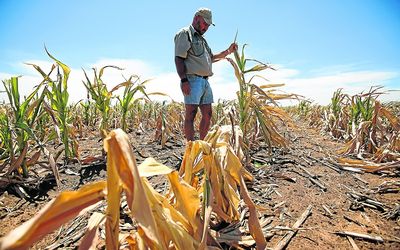Drought is catastrophic for SA’s maize production
by Ed Stoddard,
2016-01-07 05:55:18.0
A HEATWAVE is intensifying, with record temperatures expected in Johannesburg, causing dam levels to drop as SA experiences its most severe drought since 1992.
SA might need to import as much as 5-million tonnes of maize this year, about half its requirements, because of the worst drought in three decades, Grain SA said on Wednesday.
The temperature in Johannesburg is forecast to reach 38°C on Thursday, from 37°C on Wednesday, according to the South African Weather Service. The hottest day recorded in Johannesburg was November 11 last year when the temperature reached 36.5°C.
Weather stations in 24 locations across the country, including Bloemfontein in the Free State, posted record-high temperatures on Tuesday.
Even with water restrictions in place across most of the country, South African dams were only 57% full at the end of last week, compared with 82% a year earlier, Department of Water and Sanitation data show.
Pretoria will experience 41°C heat on Thursday, according to the weather service. That would equal its highest-recorded temperature. Rain and lower temperatures are predicted for both Pretoria and Johannesburg by the weekend.
The drought in Africa’s biggest maize producer has been exacerbated by an El Nino weather pattern and follows dry spells last year that reduced the crop by a third to 9.94-million tonnes, the lowest since 2007.
"We can now, with a lot of confidence, say we are in a disaster in the maize belt," Grain SA CEO Jannie de Villiers said. "We will be lucky if we produce 5-million tonnes this year and then we will need to import 5-million tonnes."
That would raise practical problems of who can supply the required commodity and whether SA is able to handle such a large volume of imports.
The Reserve Bank, which has been raising interest rates, has expressed concern about the effect of the drought and food price pressures on inflation.
Industry estimates at this stage remain fairly rough and previous predictions were for import needs ranging from 700,000 tonnes to 4-million tonnes. But the predictions have increased the longer the drought has continued.
The hardest-hit areas are in the northern Free State in the western part of the maize belt, a vital growing area. Mr De Villiers said many farmers had not planted there yet.
"The insurance companies will not pay out if the crop has not been planted and germinated by the first of January," he said. Maize in SA is generally planted in November.
The situation in the eastern part of the maize belt in Mpumalanga, which has had some rain, is not as bad, but Mr De Villiers said yields there would likely fall below average. "How are we going to import 5-million tonnes? Our port facilities cannot do that."
Transnet said last month groundwork was being done to import as much as 4-million tonnes of maize.
Mr De Villiers said the other problem was sourcing white maize, SA’s staple crop. Outside of Africa, the only other significant producers of the white variety are Mexico and the US.
South African white maize prices doubled last year and the March white maize contract hit a record close of R4,901 a tonne on Tuesday. It briefly hit a record high of R4,952 a tonne on Wednesday on Mr De Villiers’s comments before closing 0.5% lower at R4,875 a tonne.
Reuters, Bloomberg

BARREN: Paul van der Walt examines the failed maize crop on his drought-hit farm. Picture: SUNDAY TIMES
A HEATWAVE is intensifying, with record temperatures expected in Johannesburg, causing dam levels to drop as SA experiences its most severe drought since 1992.
SA might need to import as much as 5-million tonnes of maize this year, about half its requirements, because of the worst drought in three decades, Grain SA said on Wednesday.
The temperature in Johannesburg is forecast to reach 38°C on Thursday, from 37°C on Wednesday, according to the South African Weather Service. The hottest day recorded in Johannesburg was November 11 last year when the temperature reached 36.5°C.
Weather stations in 24 locations across the country, including Bloemfontein in the Free State, posted record-high temperatures on Tuesday.
Even with water restrictions in place across most of the country, South African dams were only 57% full at the end of last week, compared with 82% a year earlier, Department of Water and Sanitation data show.
Pretoria will experience 41°C heat on Thursday, according to the weather service. That would equal its highest-recorded temperature. Rain and lower temperatures are predicted for both Pretoria and Johannesburg by the weekend.
The drought in Africa’s biggest maize producer has been exacerbated by an El Nino weather pattern and follows dry spells last year that reduced the crop by a third to 9.94-million tonnes, the lowest since 2007.
"We can now, with a lot of confidence, say we are in a disaster in the maize belt," Grain SA CEO Jannie de Villiers said. "We will be lucky if we produce 5-million tonnes this year and then we will need to import 5-million tonnes."
That would raise practical problems of who can supply the required commodity and whether SA is able to handle such a large volume of imports.
The Reserve Bank, which has been raising interest rates, has expressed concern about the effect of the drought and food price pressures on inflation.
Industry estimates at this stage remain fairly rough and previous predictions were for import needs ranging from 700,000 tonnes to 4-million tonnes. But the predictions have increased the longer the drought has continued.
The hardest-hit areas are in the northern Free State in the western part of the maize belt, a vital growing area. Mr De Villiers said many farmers had not planted there yet.
"The insurance companies will not pay out if the crop has not been planted and germinated by the first of January," he said. Maize in SA is generally planted in November.
The situation in the eastern part of the maize belt in Mpumalanga, which has had some rain, is not as bad, but Mr De Villiers said yields there would likely fall below average. "How are we going to import 5-million tonnes? Our port facilities cannot do that."
Transnet said last month groundwork was being done to import as much as 4-million tonnes of maize.
Mr De Villiers said the other problem was sourcing white maize, SA’s staple crop. Outside of Africa, the only other significant producers of the white variety are Mexico and the US.
South African white maize prices doubled last year and the March white maize contract hit a record close of R4,901 a tonne on Tuesday. It briefly hit a record high of R4,952 a tonne on Wednesday on Mr De Villiers’s comments before closing 0.5% lower at R4,875 a tonne.
Reuters, Bloomberg



















Change: 0.38%
Change: 0.46%
Change: -0.77%
Change: 0.58%
Change: 1.34%
Data supplied by Profile Data
Change: 0.49%
Change: -0.75%
Change: 0.38%
Change: 0.00%
Change: -1.01%
Data supplied by Profile Data
Change: 0.57%
Change: 0.04%
Change: 0.17%
Change: 0.44%
Change: 0.46%
Data supplied by Profile Data
Change: -0.51%
Change: 0.42%
Change: -0.26%
Change: 1.29%
Change: 0.94%
Data supplied by Profile Data